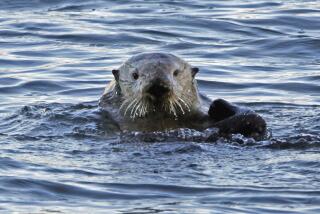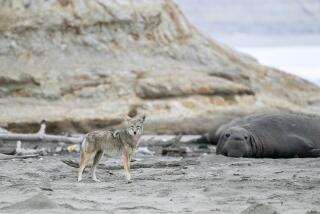Trade, Pollution Pose Big Threats to Sea Horse
- Share via
EXETER, England — A creamy yellow sea horse sidles up to her partner. Heads tucked, they link curling tails and pirouette for a minute or two through fluttering green weeds.
This aquatic pas de deux at the Seahorse Nature Aquarium is repeated each morning during the two- to four-week pregnancies of the males.
In a parenting twist that has endeared the fish to feminists, it’s the male sea horse that incubates eggs deposited in his brood pouch by the female.
Sea horses have no problem breeding, but only one in a thousand will reach maturity in the wild. Of those, tens of millions are captured and processed annually for use in aquariums, as trinkets and food delicacies, and as medicines and aphrodisiacs in Asia.
“The threats are great to sea horses around the world,” said Dr. Amanda Vincent, the Darwin senior research fellow at Oxford University’s department of zoology and one of the world’s leading experts on sea horses.
Captive breeding programs are underway in at least eight countries--but with limited success. Despite expert care, few offspring escape death from starvation or disease.
Neil Garrick-Maidment, a dedicated amateur who owns the Seahorse Nature Aquarium in Exeter, 170 miles southwest of London, is searching for a diet that will allow young sea horses to thrive.
Each day a baby sea horse eats 3,000 brine shrimp--crustaceans so small they look like air bubbles in the tank.
“We use brine shrimp as a carrier feed food--almost like the bread on a sandwich,” he said. “Bread has a little nutrition in it, but unless you put something inside the sandwich, it isn’t very worthwhile eating.”
In bubbling flasks, Garrick-Maidment feeds algae, yeast and other nutrients to the brine shrimp before feeding them to the baby sea horses.
If the diet problem can be solved, Vincent said, captive breeding centers may be set up in countries where sea horses are an important part of the local economy.
“My goal is clearly and definitely to protect the sea horse population. But I have to accept that there will continue to be a sea horse fishery,” Vincent said.
Trade in sea horses is increasing rapidly, mostly in China, where demand for traditional medical products has risen with economic growth.
Chinese use at least 20 million of the tiny creatures each year to treat asthma, arteriosclerosis, broken bones, incontinence, impotence, kidney disorders, skin ailments and thyroid disorders, Vincent said.
Annually, souvenir hunters buy about a million sea horses fashioned into key chains, jewelry, paperweights and dried decorations. Hundreds of thousands end up in aquariums, where they usually die quickly.
Occasionally, sea horses appear on exotic menus.
Dredging, dumping, polluting, silting and clearing of coastal waters do additional damage by destroying sea horse habitat.
No one knows how many sea horses exist in the wild, but experts fear that pressures of trade and pollution may send the sea horses galloping into oblivion.
From Canada to Australia, a species or two is found in most coastal areas with sea-grass beds, mangroves or coral reefs. Worldwide, there are perhaps 35 species.
The smallest species have fewer than 10 offspring. Then there was James, a Hippocampus reidi, with a pouch of half a tablespoon in volume, who shot out a string of 1,572 babies. End to end, they would have stretched 12 yards.
Just 1/4-inch-long when born, sea horse species grow to 2 to 12 inches.
Countries that trade in sea horses include Australia, Belize, Brazil, China, Dubai, Ecuador, India, Indonesia, Italy, Japan, Kuwait, Malaysia, Mexico, New Zealand, Pakistan, the Philippines, Singapore, Spain, Sri Lanka, Tanzania, Taiwan, Thailand, United Arab Emirates, the United States and Vietnam.
Last year, collectors in the central Philippines were paid up to 50 cents per dead sea horse or 25 cents per live sea horse, Vincent said. In Hong Kong, mixed-species, medium-sized, unbleached sea horses sold for $280 per kilogram; large bleached sea horses fetched $1,200 per kilogram. A kilogram is 2.2 pounds.
Exporting sea horses is reported to be among the most lucrative fishing businesses in Vietnam and the Philippines. Vincent says it would be fruitless to ban the trade.
“If we lose the help and cooperation of informants along the way, we’ll only be hurting ourselves and driving the trade underground,” she said.
Working with local groups, Vincent is encouraging community-based sea horse management projects in the Philippines and Vietnam.
In the Philippines, villagers are reseeding protected areas with wild sea horses and holding pregnant males in cages until they give birth. They also participate in sea horse censuses and report daily catches, providing data about sea horse growth and reproduction.
More to Read
Sign up for Essential California
The most important California stories and recommendations in your inbox every morning.
You may occasionally receive promotional content from the Los Angeles Times.










